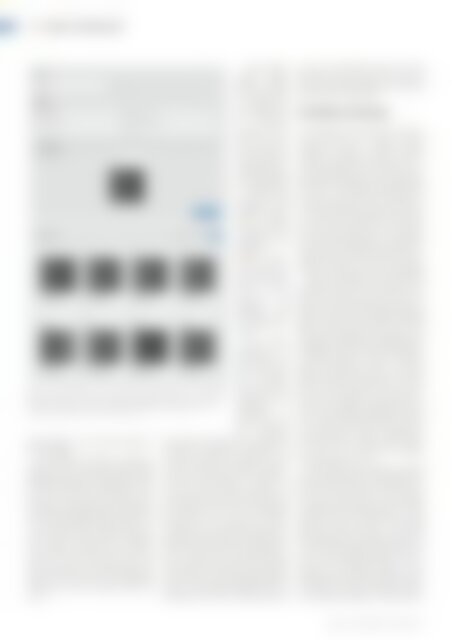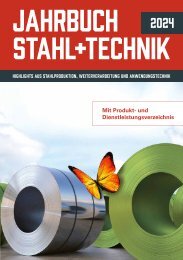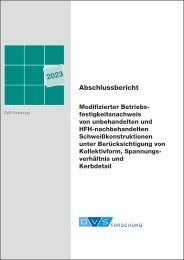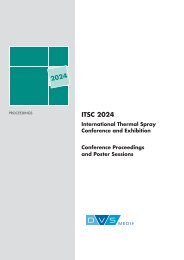STEEL + TECHNOLOGY 04/2019 EXTRACT
STEEL + TECHNOLOGY 04/2019 EXTRACT
STEEL + TECHNOLOGY 04/2019 EXTRACT
Create successful ePaper yourself
Turn your PDF publications into a flip-book with our unique Google optimized e-Paper software.
66 | <strong>STEEL</strong> <strong>TECHNOLOGY</strong><br />
Figure 3. With the deep learning based SST Image Search millions<br />
of defect images can be searched in fractions of a second (Picture:<br />
SST; Example defects: NEW dataset [10])<br />
severe defects in the relatively large corpus<br />
of images.<br />
To illustrate the problem, consider a<br />
classifier that correctly classifies shell<br />
defects against other defects with a 90%<br />
probability. Applied to 1,000 defect images<br />
of a coil that contains 50 shells, such<br />
a classifier would report only 45 correctly<br />
as shells. Applying the 90% probability to<br />
the remaining 950 images that do not<br />
contain a shell would yield 95 “false positive”<br />
shells. In total, such a classifier<br />
would assign 140 images to the shell category,<br />
of which only about one third<br />
would correctly be in the shell defect category.<br />
The user now has a reasonable<br />
impression that the classifier does not<br />
work.<br />
Such a system<br />
would detect<br />
severe defects<br />
for nearly every<br />
coil, triggering a<br />
mandatory manual<br />
follow-up<br />
inspection process.<br />
The problem<br />
cannot simply<br />
be solved by<br />
changing the sensitivity<br />
thresholds<br />
for classification<br />
to reduce false<br />
negatives, as the<br />
accuracy (precision)<br />
is always<br />
increased at the<br />
expense of the<br />
sensitivity<br />
(recall). Insufficient<br />
recall, however,<br />
means that<br />
serious errors<br />
may not be<br />
detected and<br />
defective coils<br />
are released as a<br />
result.<br />
The defect<br />
distribution of<br />
the test set must<br />
be chosen carefully.<br />
Consider<br />
that the test set<br />
should mirror the<br />
distribution of<br />
production in<br />
order to increase<br />
the likelihood<br />
that measured performance values are<br />
matched in production. However, the<br />
accuracy measure of a classifier on such<br />
a test set would not reflect the performance<br />
of the classifier with respect to<br />
rare and severe defects, though it is<br />
exactly these rare and severe defects that<br />
are often the central focus of classification<br />
systems. As a rule, a compromise<br />
between the two extremes is recommended:<br />
test sets should represent both<br />
defects that are frequent in production as<br />
well as those that are metallurgically relevant.<br />
The test set should also challenge<br />
the classifier to the extent that improvements<br />
in accuracy can be detected when<br />
further training data is added. With the<br />
assistance of the SST Training Set Optimizer,<br />
such an effective test set can be<br />
generated. These test sets can then be<br />
used to realistically assess the classifier<br />
performance in production.<br />
Classification technology<br />
A well-performing classifier is the most<br />
critical element of a reliable surface<br />
inspection system. Typical surface<br />
inspection systems only make use of conventional<br />
classifiers which extract manually-designed<br />
features for use during classification<br />
[1]. These features are optimized<br />
for use on many different materials such<br />
as paper, glass, fabric, steel, foil and plastic.<br />
If surface defects differ due to a property<br />
that is not mapped within this relatively<br />
limited feature set, such defects<br />
cannot be distinguished by the classifier.<br />
Furthermore, the features are often considered<br />
as trade secrets and the manual<br />
addition of features is simply impossible.<br />
After the publication of the AlexNet<br />
architecture in 2012 by Krizhevsky, Sutskever<br />
and Hinton [2], which has since<br />
been cited by over 40,000 scientific publications,<br />
a new era of image processing<br />
began. Deep neural networks achieved<br />
85% top-5 classification accuracy in the<br />
ImageNet Large Scale Visual Recognition<br />
Challenge, over 10% more than traditional<br />
image recognition systems. The latest<br />
deep convolutional neural networks<br />
(CNN) achieve a top-5 accuracy of up to<br />
98% in the same benchmark, a performance<br />
that is superior to human test subjects.<br />
Due to CNNs’ unprecedented success<br />
in the ImageNet challenge, it should<br />
not come as a surprise that they also provide<br />
significantly higher classification<br />
accuracy levels in steel surface inspection<br />
than the conventional methods<br />
described above [4 – 9].<br />
Smart Steel Technologies uses deep<br />
learning technology for automated surface<br />
inspection and precise defect classification<br />
on GPU servers. The company<br />
has been developing custom-built CNN<br />
architectures for classification of steel<br />
defects for several years. These deep<br />
learning systems are often more than<br />
10% better than traditional systems on<br />
the same training and test data. The software<br />
can be integrated directly into production<br />
with read-only access to the<br />
databases of an existing surface inspection<br />
systems without any need for expensive<br />
hardware upgrades. The clear advan-<br />
<strong>STEEL</strong> + <strong>TECHNOLOGY</strong> 1 (<strong>2019</strong>) No. 4


















